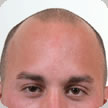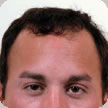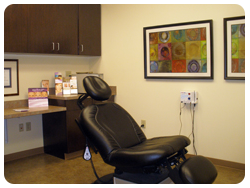Hair Replacement Surgery Process Indianapolis
For men, heredity is the major factor in hair loss.
For women, hormonal changes, including those that occur during menopause, are mainly responsible for female “pattern changes,” which include thinning and loss. Accidents, burns, and diseases can also trigger hair loss.
 Before
Before After
AfterThe key factor in hair replacement is the presence of the donor’s hair on the side or back of the scalp, which is then used to replace hair where loss has occurred. Total baldness makes hair replacement surgery impossible. Hair quality is another factor. Light-colored hair, as well as coarse-textured hair, produces a look of greater density than fine or dark hair.
It is not essential to be bald or nearly bald before undertaking hair transplantation. Age is also not a contraindication for a hair transplant. The younger the person, though, the more conservative the approach must be for hair transplantation because the permanent donor site may not yet be established. Ideally, the patient should have densely growing hair at the donor sites to sufficiently fill any present or future areas of baldness.
What’s Involved In Hair Replacement Surgery?
Typically, our hair replacement surgery involves removing a very thin strip of hair from the back of the patient’s head. This strip is dissected into hundreds or thousands of smaller grafts by technicians utilizing various magnification methods. Then our surgeon makes tiny incisions in the scalp and individually transplants these follicle grafts. Most grafts contain one or two hairs, with occasional use of larger four- or five-hair grafts. The artistic arrangement of these grafts and incisions is placed in such a manner as to create a natural hairline. While this method has the advantages of a higher yield and an easily covered recipient area post-procedure, it does leave a fine-line scar, which for most patients is easily covered by their hair. For patients who wear their hair very short, ffollicular unit extraction (FUE) is an option, as it leaves no linear scar. Instead, the grafts are removed individually and require a longer procedure. Long-term, however, it is difficult to detect any evidence of the procedure. For those who wear their hair extremely short, FUE is a great option for obtaining a great result without any visible scars.
Related Review
“The procedure itself went so well”
I would like to show my gratitude for the entire process of having the hair transplant. From the consultation, to surgery, everything went absolutely perfect. The treatment by yourself and staff made the whole process feel so comfortable. The follow up by you calling me the evening off was very impressive. There are not many physicians that are down to earth and have this type of care for their patients.
What to Expect During Your Hair Restoration
Your hair replacement procedure in Indianapolis can last anywhere from 3 to 8 hours, depending on the number of hair grafts. It can be performed comfortably under local anesthesia in the doctor’s office, similar to what you would receive at the dentist’s office to have a cavity filled. Some patients also elect to have oral anesthesia to help them relax during the procedure. You choose what you feel will work best for you. A mild pain reliever can be prescribed after the surgery to alleviate any discomfort at the donor site you may experience, but many patients find they do not need it.
It is important to note that the hair transplant is not “plugs,” as was the case 20 to 30 years ago, but individual hair units. It is this major difference that allows us to achieve a completely natural-looking and permanent restoration of your hair.
After hair transplant surgery, you can resume most, if not all, of your normal activities almost immediately. In other words, there is no downtime besides the time it takes for the procedure!
 During the procedure in Indianapolis, you will sit comfortably in a reclined position in front of a large flat-screen television mounted on the wall. You can watch television, or you are even welcome to bring a favorite DVD to watch if you would like.
During the procedure in Indianapolis, you will sit comfortably in a reclined position in front of a large flat-screen television mounted on the wall. You can watch television, or you are even welcome to bring a favorite DVD to watch if you would like.
What to Expect After Your Procedure
After your procedure is over, you will be given post-operative care instructions to hasten the healing process. While you may resume most normal activities within hours, including washing your hair or going back to work, any strenuous exercise or lifting should not be attempted for the first 2 weeks after the procedure. A follow-up hair loss prevention treatment program is usually prescribed to promote quicker and healthier hair growth as well.
Hair Restoration Cost and Payment Options
Each hair restoration procedure is personalized to provide our patients with the best possible results. The price can range between $3,000 and $8,000 based on the type of procedure performed and the extent of the procedure. During your consultation, Dr. Biggerstaff can go over the potential cost of your hair replacement surgery in Indianapolis. We do offer financing options.
Schedule a Consultation
If you are bothered by your hair loss and are looking for a skilled and experienced surgeon to perform your hair restoration procedure, contact Follicles Hair Loss Clinic in Indianapolis today to schedule a consultation with Dr. Biggerstaff.
Related Blog Posts
What Is Follicular Unit Extraction (FUE)?
 Follicular unit extraction is a hair transplant technique that can provide results that are natural-looking and long-lasting. A follicular unit refers to a group of one to four hairs along with the glands and nerves they are attached Read More
Follicular unit extraction is a hair transplant technique that can provide results that are natural-looking and long-lasting. A follicular unit refers to a group of one to four hairs along with the glands and nerves they are attached Read More
Which is better – PRP or a Hair Transplant?
 Platelet Rich Plasma (PRP) is the latest rage in the hair restoration field. This non-surgical treatment involves treating the scalp with a portion of the patient’s blood, rich in platelets, to stimulate hair growth. The exact mechanism of how this Read More
Platelet Rich Plasma (PRP) is the latest rage in the hair restoration field. This non-surgical treatment involves treating the scalp with a portion of the patient’s blood, rich in platelets, to stimulate hair growth. The exact mechanism of how this Read More

